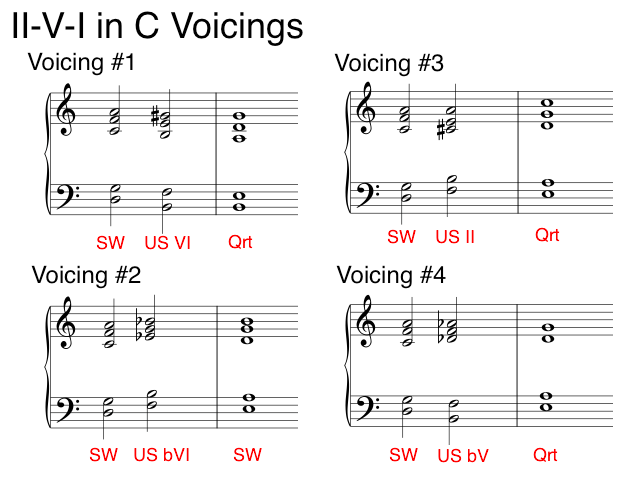Simplified Notation
We have already encountered Slash Chords in a previous lesson, where we came across the idea of simplifying chord notation by breaking the chord up into components. Upper Structures follow a similar logic.
Upper Structures
Upper Structures are a nice sounding and simple way to voice altered dominant chords. They are simply a triad over a tritone.
They always have a 3rd & 7th in the left hand (which is a tritone apart in a V7 chord) and some kind of triad in the right hand. The triad you play is specified by a number which indicates the root note of the triad relative to the root note of the overall V7 chord. And the triad can be played in any inversion (though you should generally keep the top note in your left hand and the bottom note in your right hand no more than a Perfect 5th apart).
Upper Structures exist because:
- They are an easier way to think about complex chords;
- They give a ready-made voicing for the chord.
Upper Structures are analysed just like any other chord – by looking at the notes they are composed of. And because they are all V7 chord, some of the voicings have equivalent tritone substitution Upper Structures. If you want to hear one particular chord as opposed to it’s tritone substitution (say, C7 instead of F#7), all you have to do is add the relevant root note in the bass (say, a C).
Below is a list of the all the available Upper Structures, including their tritone substitution where applicable.
| US | Chord | LH | RH Chord | RH Notes | Tritone sub (F#7) |
|---|---|---|---|---|---|
| US II | C7#11 | E-B♭ | D | D-F#-A | US ♭VI |
| US ♭III | C7#9 | E-B♭ | E♭ | E♭-G-B♭ | US VI |
| US ♭V | C7♭9#11 | E-B♭ | G♭ | D♭-G♭-B♭ | NA |
| US ♭VI | C7#9♭13 | E-B♭ | A♭ | E♭-A♭-C | US II |
| US VI | C7♭9 | E-B♭ | A | A-C#-E | US ♭III |
| US Im | C7#9 | E-B♭ | Cm | E♭-G-C | US #VIm |
| US ♭IIm | C7♭9♭13 | E-B♭ | D♭m | F♭-A♭-D♭ | NA |
| US ♭IIIm | C7#9#11 | E-B♭ | E♭m | E♭-G♭-B♭ | NA |
| US #IVm | C7♭9#11 | E-B♭ | F#m | C#-F#-A | US Im |
| US VII | C7sus | C-G | B♭ | F-B♭-D | NA |
Combining Quartal, So What and Upper Structure Voicings can sound very smooth and is used a lot in Modern Jazz piano.
| Voicing | ii (So What) | V (US) | I (Quartal) | |
|---|---|---|---|---|
| Basic Chord Progression | Dm11 | G13 | CMaj9 | |
| Voicing #1 | D-G C-F-A | US VI | B-F B-E-G# | B-E A-D-G |
| Voicing #2 | D-G C-F-A | US ♭VI | F-B E♭-G-B♭ | E-A D-G-B (So What) |
| Voicing #3 | D-G C-F-A | US II | F-B C#-E-A | E-A D-G-C |
| Voicing #4 | D-G C-F-A | US ♭V | B-F D♭-F-A♭ | E-A D-G |

Try these out and listen to how smoothly they transition from chord to chord and how the harmonies interact.